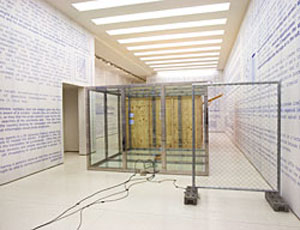3.4.24 — Dead Giveaway
You know what they say about conceptual art: you can’t give it away.
Rirkrit Tiravanija disagrees, and he should know. He has been giving it away for thirty years now, and people are, literally, eating it up. I have had his Thai curry more than once in the galleries and received compliments on his free t-shirts, with their cryptic but high-minded messages giving nothing away. If that has you nodding off,  he has served strong coffee to museum-goers who might balk at the café’s prices and invited others to make tea. He has built his own radio tower to get out the message. Now MoMA PS1 devotes more than a full floor to his equally high-minded career, through March 4.
he has served strong coffee to museum-goers who might balk at the café’s prices and invited others to make tea. He has built his own radio tower to get out the message. Now MoMA PS1 devotes more than a full floor to his equally high-minded career, through March 4.
I do not often think of ping-pong as a spectator sport, but Tiravanija sets out a table in the museum’s two-tier gallery, so that anyone can play and spectators can look down as in an arena. Mañana Es la Cuestión, its surface reads, and people line up in a photograph behind it, forming a question mark in front of Mexico City’s grandest cathedral. He relishes collaborators, and he sees tomorrow as an eternally open question. Just who will come together for an answer? Could it be you? That still leaves him front and center, and his menu may be getting old, but such is conceptual art.
Tn truth, the opening line was mine—an attempt to play on the nature of conceptual art. If there is only a concept, there is nothing to give away. That is not true for all conceptual art, which can be physical indeed, and it is not true either for Rirkrit Tiravanija. His retrospective includes old pots and bottles that went into his curries, looking only mildly disgusting, and the show’s largest room is set out spotlessly for cooking anew. He serves curry only on weekends during the course of the show, and coffee is available only late Fridays, but you can make tea anytime. Come on a Monday, and you can probably snag the ping-pong table (but no t-shirts).
Tiravanija will always be torn between the physical and the conceptual, what a past show called “theanyspacewhatever.” The show opens with a wooden shed that replicates the layout of one of his earliest exhibitions. Sure enough, its first room is cluttered with memories cast in chrome—an old TV, VCR tape, crumpled clothing, and an Andy Warhol silkscreen of Chairman Mao. Sure enough, too, its second room lies empty. Back in 2007, I reflected at length on what it means to be an idealist in mainstream art institutions, and I leave it to you to read more for the full story. Here I ask only how that plays out at MoMA PS1.
For one thing, he sees himself as catering to basic human needs, like food and clothing, and he has replicated his bedroom for a promise of shelter—like the artist known as Puppies Puppies in the lobby gallery of the New Museum and Andrea Zittel before her. Yet needs are immediate, and that bedroom is long gone. He sees his work, too, as for all the senses, including taste and smell. Yet it depends on the bare fact of familiar objects. He sets out the instruments of a rock band, quality instruments at that, for others to play, along with recording equipment. I did not dare to pick up a guitar, but music and silence alike are in the air.
For another, it can grow seriously self-involved. You cannot have slept in his bedroom or on an orange mat, here topped by a backpack. He carried them on his way to an exhibition, sleeping where he could and walking on open ground. Was that humility or all about him? The question dogs all his work—and an entire movement devoted to giving things away, Relational Esthetics. Just when does giving become a true collaboration with the receiver?
It can also devolve into nostalgia. Back in his chrome days, Tiravanija also cast the urinals at CBGB. I miss the place myself, but not that much. All the same, art for him is political, like the slogans on his t-shirts. One of my souvenirs from past shows reads Freedom Cannot Be Simulated. Paintings on newsprint read Fear Eats the Soul, Less Oil More Courage, and The Days of This Society Is Numbered. A wall-sized painting becomes a simulated brick wall, in the style of Philip Guston.
Yet it cannot be too clear or too political. You will not find Guston’s KKK here, and that goes with the further tension between collaboration and taking a stand. As the retrospective’s title has it, he is catering to “A Lot of People.” No wonder he has always served mild curry. As an artist from Thailand born in Argentina and able to remember the bathroom at CBGB in New York, he knows at firsthand what it is like to build bridges. His work almost sinks under the tensions, and I came away without a freebie, a meal, or much in the way of insight, but the welcome was real.
Read more, now in a feature-length article on this site.